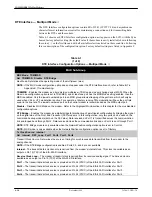
DCP Configuration
4-23
3920-A2-GN31-30
November 1996
Table 4-3
(2 of 2)
Dial Line Configuration Options — Multiport Mode
l
Dial Tx Level: Permissv(–9)
Nxt Permissv(–9) –10 –11 –12 –13 –14 –15 –16 –17 –18 –19 –20 –21 –22 –23 –24 –25 –26 –27 –28 –29
–30 –31 –32
Dial Transmit Level. Selects the modem’s transmit power level over dial lines. The transmit output level can be selected
in 1 dBm decrements from –9 dBm to –32 dBm.
NOTE: In North America the range of allowable values is –10 dBm to –32 dBm, plus Permissive (–9 dBm). This
configuration option is locked in other countries (the user cannot change the level).
NOTE: The factory default setting is country dependent. Default is Permissv(–9) in North America.
Train Time: Long
End Long Short
Train Time. Controls V.34 and V.32 family train time. Determines whether minimum or maximum time durations are used
during the handshaking sequence for both dial and 4-wire/2-wire leased-line applications.
Long – Selects long train. Use this setting whenever far-end frequency offset (phase roll) may be encountered. This is
usually only required when transmitting over satellite links.
Short – Allows the modem to train-up faster when using V.32 terbo, V.32bis, or V.32 modulation.
Asymmetric Rate: Disabled
Nxt Enable Disable
This configuration option does not appear unless V.34 is enabled.
Asymmetric Rate. Controls rate symmetry when running V.34 modulation by enabling or disabling the V.34 modulation
from using equal transmit and receive rates.
Enable – The modem operates in asymmetric rate mode (the transmit and receive rates can be different) when running
V.34 modulation. The Asymmetric Rate configuration option must be enabled in both modems.
Disable – The modem operates in symmetric rate mode (the transmit and receive rates are identical) when running V.34
modulation. Either modem can force symmetric mode by disabling the Asymmetric Rate configuration option.
















































